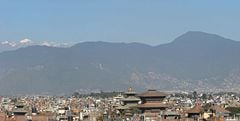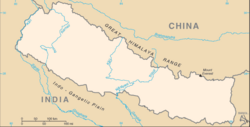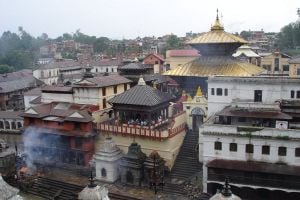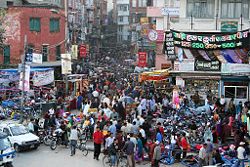Difference between revisions of "Kathmandu" - New World Encyclopedia
Mike Butler (talk | contribs) (New page: {{Infobox Settlement <!--See the Table at Infobox Settlement for all fields and descriptions of usage—> <!-- Basic info ----------------> |official_name = Kathmandu Metropolitan...) |
Mike Butler (talk | contribs) |
||
| Line 173: | Line 173: | ||
== Economy == | == Economy == | ||
| − | + | Nepal is among the poorest and least developed countries in the world with almost one-third of its population living below the poverty line. Agriculture is the mainstay of the economy, providing a livelihood for three-fourths of the population and accounting for 38% of GDP. Industrial activity mainly involves the processing of agricultural produce including jute, sugarcane, tobacco, and grain. | |
| − | a | ||
| − | |||
| − | |||
| − | |||
Per capita GDP, rank | Per capita GDP, rank | ||
| Line 257: | Line 253: | ||
{{Commons|Kathmandu}} | {{Commons|Kathmandu}} | ||
* {{wikitravel}} | * {{wikitravel}} | ||
| + | * Encyclopaedia Britannica [http://www.britannica.com/EBchecked/topic/313253/Kathmandu.htm Kathmandu] Retrieved December 10, 2008. | ||
| + | * World Fact Book 2008 [https://www.cia.gov/library/publications/the-world-factbook/geos/np.html Nepal] Retrieved December 10, 2008. | ||
* [http://www.mapmandu.com Explore and discover Kathmandu on a digital Map] | * [http://www.mapmandu.com Explore and discover Kathmandu on a digital Map] | ||
* [http://www.colorfulnepal.com/world-heritage-sites.html Information on Cultural Heritage in Kathmandu With Pictures] | * [http://www.colorfulnepal.com/world-heritage-sites.html Information on Cultural Heritage in Kathmandu With Pictures] | ||
Revision as of 03:57, 10 December 2008
| Kathmandu Metropolitan City येँ महानगरपालिका ñē̆ dēy (ञेँ देय्) Kantipur |
|
| Coordinates: 27°42′N 85°20′E | |
|---|---|
| Country | Nepal |
| Development Region | Central |
| Zone | Bagmati |
| District | Kathmandu |
| Established | 723 [1] |
| Government | |
| - Prime Minister | Pushpa Kamal Dahal 'Prachanda'[1] |
| Area | |
| - Total | 50.67 km² (19.6 sq mi) |
| Population (2001) | |
| - Total | 671,846 |
| Time zone | GMT +5:45 (UTC) |
| Website: http://www.kathmandu.gov.np/ | |
Kathmandu (Nepali: काठमांडौ, Nepal Bhasa: येँ) is the capital and the largest city of Nepal. The city is situated in Kathmandu Valley that also contains two other cities - Patan and Bhaktapur. Nepali is the lingua franca of the valley and is the most widely spoken language. Nepal Bhasa/Newari is the language spoken by native people, the Newars. Hindi and English are understood by most of the educated population of the city. The city stands at an elevation of approximately 4,500 ft (1,400 m) and is inhabited by about 700,000 people. Kathmandu is the most developed city in Nepal.
Geography
Etymology of name – if available.
The city is located in the northwestern part of Kathmandu Valley. The Kathmandu Valley covers an area of 218 sq. miles. It is situated at 1336 m above the sea level. Bagmati, Bishnumati, Dhobikhola, and Tukucha rivers wind through the city. Elevation Climate (not required unless it makes the city a resort) The city (Johannesburg) enjoys a dry, sunny climate, with the exception of occasional late afternoon downpours in the summer months of October to April. Temperatures are usually fairly mild due to the city's high altitude, with the average maximum daytime temperature in January of 79°F (26°C), dropping to an average maximum of around 61°F (16°C) in June. Winter is the sunniest time of the year, with cool days and cold nights. The temperature occasionally drops to below freezing at night, causing frost. Snow is rare. Mean annual precipitation is 28 inches (716mm). Rivers and canals Size – land area, size comparison Environmental issues Districts
History
Kathmandu is situated in the heart of the Himalaya mountains, and has a rich history. Considered by some to be among the most beautiful cities in the world, the earliest known inscription in the Kathmandu Valley is dated 185 C.E. The oldest firmly dated building in the earthquake-prone valley is almost 1,992 years old. Four stupas around the city of Patan said to have been erected by Charumati, attest to the ancient history present within the valley. The Kirats are the first documented rulers of Kathmandu Valley, the remains of their palace are in Patan near kendra Hiranyavarna Mahavihara (called "Patukodon"). The Licchavi Dynasty whose earliest inscriptions date back to 464 C.E. were the next rulers of the valley. The Malla Dynasty consisted of Newar rulers, who ruled Kathmandu Valley and the surrounding area from the 12th century till the 17th century when the Shah Dynasty founder Prithvi Narayan Shah conquered the valley as he created present-day Nepal. Most of ancient Nepali Architecture present in Nepal today is from the Malla/Newar era.
The city of Kathmandu is named after a structure in Durbar Square called Kaasthamandap. In Sanskrit, Kaasth (काष्ठ) is "wood" and Mandap (मंडप/मण्डप) is "covered shelter." This unique temple, also known as Maru Sattal, was built in 1596 C.E. by King Laxmi Narsingh Malla. The entire structure contains no iron nails or supports and is made entirely from wood. Legend has it that the timber used for this two story pagoda was obtained from a single tree.
Kathmandu is also sometimes called "Kantipur". Kanti is an alternate name of the Goddess Laxmi, and Pur meants the place where such a goddess resides; thus, the name Kantipur demonstrates the ancient belief that it is the place where Laxmi dwells. Newars, the native people of the Kathmandu valley use the original term from Nepal Bhasa, Yne.
Present
Being the capital city of Nepal, Kathmandu is home to most of the government offices, embassies, corporate houses, and the palace. A golden heaven to the most famous artists in the world, it has the old palace of Newar kings, Kathmandu Durbar Square, which is listed as UNESCO world heritage site, is in Basantapur, next to Freak Street, which was the popular hippie spot during the seventies. The Shah King's Palace stands right next to Thamel - the tourist hub of the country. A small world within itself, Thamel is famous for the most attractive hotels and shopping centers in the world. It consists of two parallel streets just to the west of the palace. It is home to world famous hotels, ranging from different stars. The palace is at the head of Durbar Marg, a street lined with various shops. Most of the streets in Kathmandu are named from Nepal Bhasa, owing its origin to the rich Newari Culture and heritage. In a sense, Kathmandu is the most read text in the field of culture, history and Newari civilization in South Asia.
The "old" city is noted for its many Buddhist and Hindu temples and palaces, most dating to the 17th century. Many of these landmarks have been damaged by earthquakes and pollution. This valley hosts an UNESCO World Heritage Sites composed by seven different Monument Zones: The centers of the three primary cities, Kathmandu Hanuman Dhoka, Patan and Bhaktapur, the two most important Buddhist stupas, Swayambhunath and Boudhanath and two famous Hindu shrines, Pashupatinath temple and Changu Narayan. Since 2003 the site has been inscribed in the World Heritage List as being "in danger" out of concern for the ongoing loss of authenticity and the outstanding universal value of the cultural property.
Kathmandu has been popular with western tourists since the 1960's when it became a key stop on the Hippy Trail, when Jho: Chheen (Nepal Bhasa, continuous house)(Freak Street) was the one of the main location. It is also the subject of a popular Bob Seger song for the same reason. It is rumoured that many rock singers used to visit Jho: Cheen and downtown Kathmandu in search of tranquility and Nirvana.
Tribhuvan International Airport is located about 25 km from the city center, offering domestic and international flights.The last name of Gautam is quite famous in Kathmandu.
Government
The city is looked after by Kathmandu metropolitan office located at Bagdarbar. The city hosts Singhadarbar, the government seat of Nepal (with office of Prime Minister, Supreme Court and Senate). Most of the ministries are present in the Singha Darbar premises. The Royal Palace is located in central part of city in ward number 1.
The metropolitan has been divided into around 5 sectors by metropolitan authorities as follows[2]
Central sector
The central sector consists of wards 1, 5, 11, 31, 32 and 33.
East sector
The east sector consists of wards 6, 7, 8, 9, 10(Baneshwor), 34 and 35.
North sector
The north sector consists of wards 2, 3, 4, 16, 29.
City core
This is the most densely populated part of the city. This part consists of most of the historical and cultural monuments of the city.
West sector
The west sector consists of wards 13, 14 and 15.
Economy
Nepal is among the poorest and least developed countries in the world with almost one-third of its population living below the poverty line. Agriculture is the mainstay of the economy, providing a livelihood for three-fourths of the population and accounting for 38% of GDP. Industrial activity mainly involves the processing of agricultural produce including jute, sugarcane, tobacco, and grain.
Per capita GDP, rank Financial and business services sector Tourism Manufacturing Transport: Road, rail, air, sea The city is a hub for Germany’s and Europe’s high-speed passenger rail network. Autobahns radiate from Cologne's ring road. Cologne's international airport is Cologne Bonn Airport, also called Konrad Adenauer Airport. The Rhine harbor is one of the larger inland ports in Germany. Public transport within the city includes buses, a subway system, and the Rheinseilbahn aerial tramway crossing the Rhine. Cologne has pavement-edge cycle lanes linked by cycle priority crossings.
Kathmandu houses most of the banks, business houses, offices, organizations and share market of Nepal. The busiest economic centers are New Road of Kathmandu, Ason, Putalisadak and Darbar Marg. New Road is regarded as financial hub with presence of most of the banks in this street.
Freak Street and Thamel are main tourist areas important for tourism.
Demographics
Population, population rank Race/ethnicity - historical background of ethnic groups Language Religion Colleges and universities
According to 2001 census, there are 235,387 households in the metropolitan city[3]. Kathmandu metropolitan authorities estimate the number of people living in the city to be around 1,081,845 people [4] The largest ethnic groups are Newars, Brahmins and Kshetris. The major languages are Nepali and Nepal Bhasa. The major religions are Hinduism and Buddhism.
Cultural impact
The city has been referenced in numerous songs, including works by Cat Stevens ("Katmandu", Mona Bone Jakon (1970)), Bob Seger ("Katmandu", Beautiful Loser (1975)), Krematorij ("Kathmandu", Three Springs (2000)), Fito Páez ("Tráfico por Katmandú" — "Traffic through Kathmandu"); Will Ackerman ("A Happy Home in Kathmandu", The Opening of Doors (1993)); Tantra ("The Hills of Katmandu", early 1980s); and Godiego ("Coming Together in Kathmandu" (1980).
Numerous works of literature have been set in Kathmandu, including Kim Stanley Robinson's 1989 work, Escape from Kathmandu. Recently, the book ("Arresting God in Kathmandu") by Samrat Upadhyay has got international acclaim.
In some travelogues, the Kathmandu valley has been referred to as the "Emerald Valley".
The location is mentioned in the film Bewitched as the title of a fictional movie Will Ferrell's character stars in prior to his role in the Bewitched remake.
Gallery
Kathmandu in Popular Music
Kathmandu, mostly due to its popularity among Hippies, has been represented in various albums and songs including:
- Kathmandu, a song by Bob Seger.
- "Dum Maro Dum", a song in the movie, Hare Rama Hare Krishna by Asha Bhosle.
- "Our Shangrila", a song by Mark Knopfler.
- "Shangrila", a song by The Kinks.
- Kathmandu, a song by Cat Stevens.
- Tráfico por Kathmandú by Fito Páez.
- Kathmandu, an American heavy metal band featuring Dave King and Mandy Meyer.
- Nobody Told Me, a 1984 song by John Lennon with the line "There's a little yellow idol to the north of Kathmandu". This is a quotation from the 1911 poem "The Green Eye of the Yellow God" by John Milton Hayes.
- "A Passage to Bangkok", a song by Rush from the album 2112. "...Pulling into Kathmandu, smoke rings fill the air. Perfumed by a Nepal night, the Express gets you there..."
Sister cities
 Eugene, Oregon, United States
Eugene, Oregon, United States Matsumoto, Nagano, Japan
Matsumoto, Nagano, Japan Xi'an, People's Republic of China
Xi'an, People's Republic of China Yangon, Burma
Yangon, Burma Minsk, Belarus
Minsk, Belarus P'yŏngyang, North Korea
P'yŏngyang, North Korea
See also
- Tribhuvan International Airport
- Kathmandu Valley
Footnotes
- ↑ 1.0 1.1 Census Nepal 2001. Retrieved July 13, 2007. Cite error: Invalid
<ref>tag; name "Citydata" defined multiple times with different content - ↑ Ward Profiles, Kathmandu Metropolitan City
- ↑ Census Nepal 2001. Retrieved July 13, 2007.
- ↑ National Report 2001
External links
- Travel guide to Kathmandu from Wikitravel
- Encyclopaedia Britannica Kathmandu Retrieved December 10, 2008.
- World Fact Book 2008 Nepal Retrieved December 10, 2008.
- Explore and discover Kathmandu on a digital Map
- Information on Cultural Heritage in Kathmandu With Pictures
- Flickr.com - Sights & Scenes from Kathmandu
- Weather in Kathmandu and more
Credits
New World Encyclopedia writers and editors rewrote and completed the Wikipedia article in accordance with New World Encyclopedia standards. This article abides by terms of the Creative Commons CC-by-sa 3.0 License (CC-by-sa), which may be used and disseminated with proper attribution. Credit is due under the terms of this license that can reference both the New World Encyclopedia contributors and the selfless volunteer contributors of the Wikimedia Foundation. To cite this article click here for a list of acceptable citing formats.The history of earlier contributions by wikipedians is accessible to researchers here:
The history of this article since it was imported to New World Encyclopedia:
Note: Some restrictions may apply to use of individual images which are separately licensed.

















